W2 Class 407
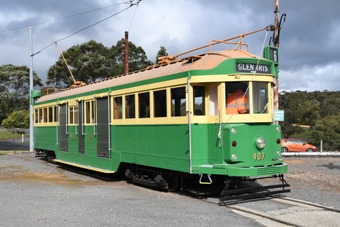
W2 407 at the top terminus. Photo Anthony Smith.
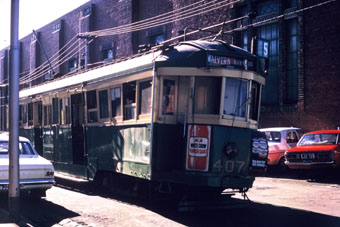
407 awaits transfer to Preston Workshops as an after last car, out of gauge movement by the R10 recovery crew.
Photo – Anthony Smith
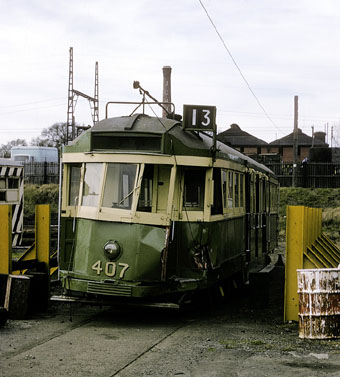
407 stabled in the straightening bay at Preston Workshops, prior to its reconstruction.
Photo courtesy Andrew Bau
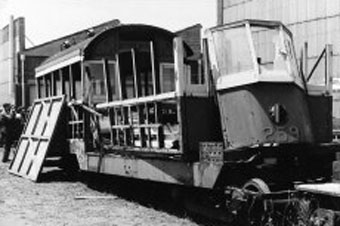
The remains of W2 259 after it was cannibalised to provide chassis, roof and other body components for 407.
Photo courtesy Doug Moyle
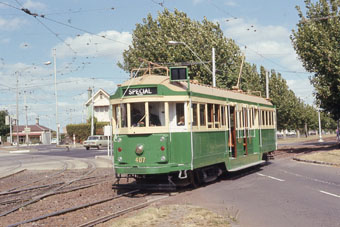
407 on an enthusiast tour, fresh from its reconstruction and seen in Dandenong Road at Wattle Tree Road corner, heading towards the intersection at Chapel Street where it suffered its significant damage in February 1972.
Photo courtesy Graeme Farrar
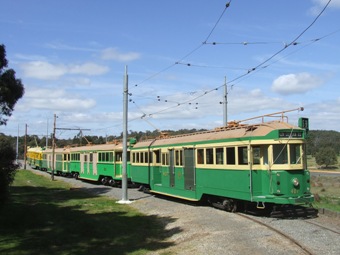
W2 407 stabled on the mainline along with W3 663, W4 670 and SW5 849. Photo Anthony Smith
W2 Class 407 entered service in Melbourne on the 5 October 1926 as a W Class tram, being converted to a W2 Class tram in the early 1930’s.
For the most part 407 is a stock-standard W2 Class tram, however its fate irreversibly changed one evening in February 1972 when it collided with a cement truck at the corner of Dandenong Road and Chapel Street.
One end of 407 was severely damaged in the collision, yet it was driven under its own power to Preston Workshops for repair. The insurance payout from the truck’s insurer was used to fund the reconstruction of 407 as an apprentice training project.
To assist in the rebuild, sister car 259 which had been withdrawn from service was dismantled to provide a replacement chassis, roof structure and other components for the damaged end of 407. This work was recorded as an 03 overhaul in 407’s car records, but was in reality more of an 01 overhaul.
Prior to returning to service, 407 was fitted with the multiple head and tail lights that were fitted to trams of this class from the early 1970’s.
407 continued to run for a number of years until it was withdrawn from service on the 12 January 1982, arriving at Haddon on the 18 February 1982 after having run a total of 2,523,134 kilometres in Melbourne.
Tram 407 was purchased without trucks and was mounted on trucks from W2 499 on arrival at Haddon. The number 4 motor in 499’s trucks was found to be defective and required replacement with a serviceable motor prior to 407 being made operable. 407 is fitted with British Thompson Houston (BTH) 265D motors, which were a favourite among tram enthusiasts for their fast running and unique sound.
407 has been restored to its final form in service as a representative of how these trams appeared in their later life.
This tram is currently on loan to the Ballarat Tramway Museum and can be viewed by visiting their museum in the Lake Wendouree gardens.
The following are W2 407’s current technical details and specifications:
Builder – MMTB’s Preston Workshops
Entered Service – 5 October 1926
Length – 14.59 metres (47ft, 10 ½in)
Height – 3.19 metres (10ft, 5 7/8in)
Width – 2.74 metres (9ft, 0in)
Weight – 16.52 tonnes (16.2 tons)
Seated Passengers – 52
Trucks – MMTB No. 1A, 26 ½” tyred wheels
Traction Motors – 4 x 30 kW (40HP) British Thompson Houston 265D
Controllers – General Electric K35JJ
Line Breaker – General Electric Type D.B. 276
Brake Valves – Westinghouse Type “W” Self Lapping
Air Compressor – General Electric Type CP27
Compressor Governor – General Electric Type ML
Braking System – Compressed air and hand applied
Maximum Acceleration – 2.5 M.P.H. per second
Maximum Design Gradient – 8.5 %
Lighting Circuits – 3 circuits each with 4 x 100 volt series lamps
Trolley Bases – MMTB